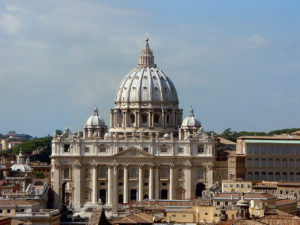Doctrine
 Medieval western Christendom, fragmented into many separate areas as we shall shortly see, was unified by broad commitment to Christianity and general acceptance of the authority of the Roman Catholic Church. The Church Fathers bequeathed to the medieval Church and its believers a rich legacy regarding Judaism and Jews, encompassing doctrine, policy, and imagery. This rich legacy was expanded and developed during our period and profoundly influenced the Jews of medieval western Christendom. For all three-doctrine, policy, and imagery, the historic ambivalence of the New Testament and the Church Fathers remained prominent. For medieval Jews, this ambivalence was positive in that it included benign and protective elements, and it was negative in that it included limiting and destructive elements. In addition, the ambivalence itself often proved dangerous, as the lower classes in European society had great difficulty in maintaining the balance that the Church demanded. For many in medieval European society, if the Jews had rejected Jesus and had forced his crucifixion, then they were objects of hostility and anger; the mitigations developed by the Church were often too complex for many among the masses to absorb.
Medieval western Christendom, fragmented into many separate areas as we shall shortly see, was unified by broad commitment to Christianity and general acceptance of the authority of the Roman Catholic Church. The Church Fathers bequeathed to the medieval Church and its believers a rich legacy regarding Judaism and Jews, encompassing doctrine, policy, and imagery. This rich legacy was expanded and developed during our period and profoundly influenced the Jews of medieval western Christendom. For all three-doctrine, policy, and imagery, the historic ambivalence of the New Testament and the Church Fathers remained prominent. For medieval Jews, this ambivalence was positive in that it included benign and protective elements, and it was negative in that it included limiting and destructive elements. In addition, the ambivalence itself often proved dangerous, as the lower classes in European society had great difficulty in maintaining the balance that the Church demanded. For many in medieval European society, if the Jews had rejected Jesus and had forced his crucifixion, then they were objects of hostility and anger; the mitigations developed by the Church were often too complex for many among the masses to absorb.
Church doctrine posited the dignity of Judaism and the Jews alongside their shortcomings. Jews were seen as the first to acknowledge God as ruler of the universe, the first bearers of the covenant with the one true God, and the first human community acknowledged by God as his chosen partners. In the Church view, the Jews had, however, from the very beginning shown signs of inability to live up to the demands of the covenantal relationship. The stories of Israelite rebelliousness against Moses and the strictures of the prophets against Israelite and Judean shortcomings were taken as vivid evidence of those early failures.
Eventually, Jewish sinfulness became unbearable, as Jesus’ Jewish contemporaries rejected the divinely appointed Messiah sent to redeem them. God had-according to the Church-no choice but to replace the Jews with a new covenant people, a new and true Israel. There were thus reasons to honor the Jews and to disdain them, reasons to respect them and to reject them. The Pauline sense of an eventual return of the Jews to their senses and an ultimate reconciliation with God further complicated matters. To the extent that this Pauline view was espoused seriously, it lent additional support to balancing the doctrinal scale. Despite the powerfully negative portrait of the Jews in the gospels, Jews were to be viewed positively in terms of both their past and their ultimate future.
Because of their past achievements and eventual future reconciliation with God, the medieval Roman Catholic Church insisted upon a legitimate place for Jews in Christian society. The basic rights of the Jews were proclaimed repeatedly by the leadership of the Church. Beginning in the twelfth century, popes promulgated regularly aConstitutio pro Judeis, a statement of basic Jewish rights, which included personal safety, protection of Jewish property, freedom from coerced conversion, and security for Jewish sacred space. Jews could not be assaulted or robbed, with the culprits maintaining that their actions were legitimate, because the victims were Jews. Jews were not to be brought to the baptismal fount by violence, and Jewish sacred space was to be inviolable
At the same time, the sinfulness of the Jews, their rejection by God, and the dangers they posed to Christian society necessitated the imposition of important limitations on Jewish behavior. Jews were not to bring any harm on either Christianity or its believers. Jewish circumstances in Christian society were therefore to be balanced, with protection and safety on the one hand and limitation and degradation on the other.



